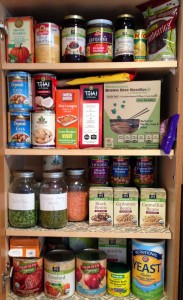It’s liberating to be able to look in your refrigerator and pantry and then whip up something that suits your mood with ingredients you have on hand. It’s easier than you might think. Begin by learning some basics, and then get in your kitchen and experiment. Just as you can create an almost infinite amount of great music knowing only a few chords, so it is with cooking. Sure you’ll be able to make more complex dishes when you learn to augment, diminish, invert, play 7th and 9ths, etc., but those simple Buddy Holly meals will provide plenty of variety and enjoyment.
Here are some tips for getting started:
- Learn some general cooking methods and techniques. If you’re a complete novice, you’ll first need to learn some basic cooking methods, such as baking/roasting, steaming, sautéing, pan frying, grilling, and stewing, to name several common methods. Start by practicing a few methods, and focus on techniques for great results. For example:
- Practice pan frying tofu, tempeh, beans, potatoes and other vegetables. Learn to properly heat the pan before adding fat and then food, and then to leave the food for appropriate amounts of time to brown all sides.
- Similarly practice baking/roasting. (Those terms are almost interchangeable. Roasting is baking at higher heats.) See my article on tips for roasting vegetables.
- Learn how to cook grains using the basic steaming/absorption method, and then perhaps try the pilaf method.
- Play around with making soups and stews, which are very forgiving.
- Learn ways to flavor food, including how to season and create a few of your favorite flavor profiles.
- Use of salt and pepper throughout the cooking process is necessary to bring out the natural flavor of foods. You “season” as you add layers of food in cooking to ensure you don’t have a bland, tasteless final dish.
- Flavor profiles are created by combining herbs and spices. Do you love Italian food? Practice combining basil, oregano, marjoram, thyme, garlic, onion, rosemary, sage, and parsley. Do you love Mexican food? Practice combining chili, cumin, coriander, paprika, garlic, onion, and cinnamon. For Indian some spices to use are curry, cumin, cloves, cinnamon, cardamom, turmeric, ginger, fenugreek, mustard, garlic and onion.
- Not as fundamental as the two above, but as a bonus, begin to learn the magic of flavor enhancers such as Dijon mustard and other condiments, Balsamic and other vinegars, wines, and tamari/soy sauce.
- In addition to learning herb and spice combinations, you’ll also be well served learning to make a few basic sauces and marinades, which you’ll be able to modify with your knowledge of flavor profiles. You might even try studying recipes to get a feel for quantities of flavorings and how flavors get balanced – a little tang from vinegar or citrus plus a little sweet from a natural sugar. My suggestions for a few sauces to start with are:
- A basic tomato sauce is one of the most fundamental and versatile sauces. For tips, check out my article.
- A basic white or béchamel sauce, cashew based, can be used in so many ways, including as a pasta sauce, for making creamy green vegetables or potatoes, enhancing casseroles, and as the basis for many cheesy sauces.
- A delicious Asian-flavored marinade/sauce can be created by combining tamari/soy sauce, garlic, and sesame oil with a little rice wine, maple syrup, and rice wine vinegar.
- Similarly, a peanut sauce can be made combining approximately equal parts peanut butter and water, then adding a little tamari/soy sauce, maple syrup, rice vinegar, ginger, garlic, and cayenne.
- Learn which foods work well together.
- First, what will make a complete, satisfying meal? You’ll want a balance of protein, starch, fat, etc. Let’s say you’ve decided to make pan fried tempeh and roasted Brussels sprouts. Will that satisfy you? Maybe roast some potatoes too for a more satisfying meal.
- Do the ingredients you have on-hand lend themselves to the cuisine you’re planning? For example, your black beans might be the perfect choice for your Mexican burrito, while cannellinis or chickpeas probably would be a better choice for your Italian wine and garlic sauce.

- With all the above in mind, keep your refrigerator and pantry well stocked so you have plenty of ingredients from which to choose. Check out my guide.

